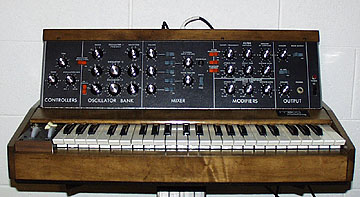
Mark's Analog Synthesizer Collection

Minimoog -
Produced from 1970 through 1982 (!). Approximately
13,000 units produced. The monophonic, classic, holy
grail of all analog synths.This one is S/N 5570, made in September of 1974. It has
a Lintronics (Big Briar) MIDI kit installed. Big fat 3 oscillator
fun! No one should be without a Mini!
Minimoog Voyager-
The classic returns! Yep, a new Minimoog from the new
Moog Music! Another Bob Moog classic...This one is serial number 43 of the Signature edition Voyagers.
The sound is pure bliss, but not an exact duplication of the original
Minimoog - and that's not a bad thing. Quite amazing - Minimoog
analog purity with modern MIDI and computer control.
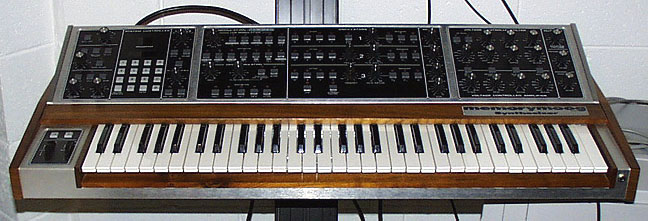
Memorymoog -
Produced from 1982 to 1985, this was the last Moog synth
made. About 3000-3500 units were sold.This one is S/N 3315, and is in absolutely MINT condition.
Just try to find a scratch. There were two versions of this synth
made: The Memorymoog and the Memorymoog Plus. The Plus
had MIDI, an improved auto tune board and some other minor
enhancements. While this one is not technically a Plus, it does
say Plus on the front panel, but not on the back. It came with
factory Moog MIDI, but now has a Kenton MIDI kit installed
along with the newer autotune board, newer power supply, and
some other tweaks, courtesy of Analogics.This is an amazing synth. Think of it as 6 Minimoogs. 6 voice
polyphonic, 100 programs, MIDI, classic Moog 24db filter,
yada, yada, yada. In monophonic mode, it can fire all 18
oscillators at once. Good God, wanna hear some bass?
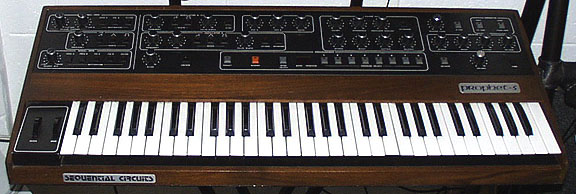
Prophet 5 -
Another classic, produced from 1978 to 1984. One of the first
programmable poly synths.This one is S/N 3610 and is a Revision 3.2, upgraded to SCI
factory MIDI (which makes it a 3.3).Used, I think, by EVERY pop/rock band of the late 70's and
early 80's. Use this simple formula:Did the band in question during the late 70's or early 80's
have any keyboards in their music? Then, Yes! They must
have used a Prophet 5! *
*Slight exaggeration for illustrative purposes only.
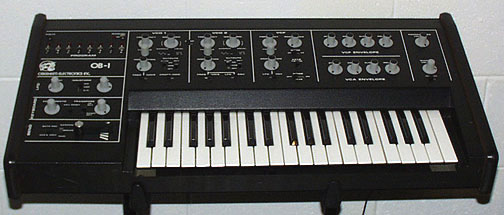
Oberheim OB-1
The first programmable mono synth, produced from 1977 to 1979.
Very hard to find, especially in this condition (GREAT!).This one is S/N 0525 out of ???? It has 8 patch memory locations to
store sounds. No MIDI (duh), but a great sound. Switchable 2 or 4
pole filter and a simple layout makes for a unique little synth. Close
to the sound of the Oberheim SEM (2, 4 or 8 voice polys).

Oberheim OB-8
Produced from 1983 to 1985. The final design in the 'OB' family
of synthesizers.This one is S/N 50501, which means nothing to me. I'm not sure
how the S/N's were implemented, but this one is the last of the OB-8s
to be produced. It's a Rev B.5, which came with factory MIDI and
the 'page 2' functions silk screened in a lighter blue on the front panel.A great sounding 8 voice synth, similar to the OB-Xa, but not as
gritty. Super pad sounds and funky effects.
Oberheim 4 Voice Polyphonic
Produced from 1974 to 1979.
This one a later model 4 voice complete with the Poly Programmer, which was
only available on later model 4 and 8 voices synths. It's in great shape for
its age, with no scratches or dents on any of the panels, and only minor wear
on the case.The 4 voice is actually 4 independent SEM modules linked together with a special
keyboard controller to produce a 4 voice polyphonic synth. You can also use the
synth in unison mode for a 4 SEM monophonic monster!Each SEM module has 2 ocillators, 2 EGs, VCF, and VCA. Note that each SEM
can be set up independently of each other one. Catch 22 - if you want a poly synth
sound, each SEM has to be set up and tuned EXACTLY as each other one. On the
flip side, you can program each SEM completely different from the next, giving you
the ability to come up with some truly unique sounds.Later, Oberheim offered an 8 voice version, which is exactly the same synth, but
with 8 SEMs. Just feel for the poor synth tech who had to set this beast up when
the likes of Denis DeYoung took it out live! Yikes!
MOTM / Synthesizers.com Modular
This beast is a combo of MOTM and Synthesizer.com modules.
There are currently 6 VCOs and multiple filters, EGs, VCAs and
other sound shaping modules.It consists of 20 MOTM modules that I built from kits. Plenty of
soldering! There are an additional 14 Synthesizer.com modules
and a .com keyboard which can send two separate CVs and Gates.The sound is amazing. 'Nuf said.
PPG Wave 2.2
Produced from 1982 to 1984.
This one is is a fine example of the Wave 2.2, only 300 of which were made while
700 of the later version 2.3s were made. This one has a couple of nice mods to it,
including a Kenton MIDI kit, and a backlit LCD screen.The Wave 2.2 (and later 2.3) used digital oscillators to produce waveforms that
were stored in 'wavetables'. These waveforms then were processed by standard
analog filters (Joy!). The result was a synth that could sound warm and rich, to
a bad assed MoFo that was as harsh and brittle as you could want.Truly one of the most unique instruments ever made. See www.ppg.synth.net
for more PPG info.
Waldorf Q
A currently produced VA synth (like the Nord and Supernova).
In my opinion, the nicest VA synth out there. WAY powerful.Check out www.midiwall.com/q for more info on this great synth.
Alesis Andromeda
A currently produced analog dream machine. This is one is a limited
red one. Big deal - it was the only one available at the time.Full analog signal path and digital control. Specs can be found all over
the web, so I won't go into it here.

Nord Lead -
OK, so it's not an analog, but rather a 'Virtual Analog'. Up against
a Mini or an OB, it sounds digital. But, it is 12 voice, 4 part multi
timbral with a great MIDI implementation and sound morphing
ability. Unique among digitals.
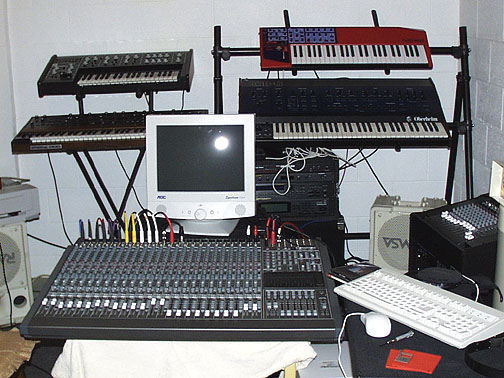
Some of my other crap -
Apple Power Mac Dual 1Ghz G4 with an Apple 17"
Studio Display running Digital Performer 3.0
through a MOTU 2408 digital audio processor and a
MOTU MIDI Express XT MIDI interface. Sorry, the
photo still shows my old PC based Cakewalk system.
Blah!
A host of Digi ROMplers:
E-Mu Proformance piano modue.
E-Mu Proteus/2 orchestral module.
Korg 01/W module.
Roland JV-1080 module with Orchestral board.
Some more offboard crap.